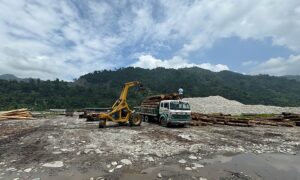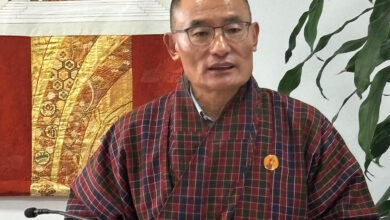Bhutan Govt. targets to extract 10.7 million cft of timber for export
The government plans to extract and export 10.7 million cubic feet (cft) of timber in 2024 as part of the Phase II nationwide scientific thinning operation.
This announcement was made by the Minister of Energy and Natural Resources, Gem Tshering, during the Meet-the-Press session yesterday.
The Department of Forests and Park Services (DoFPS) has rolled out the Phase II operation, with the Natural Resources Development Corporation Limited (NRDCL) allocated 3.7 million cft for extraction this year across approximately 12 dzongkhags.
An official from the DoFPS said that it is extremely difficult to project the revenue generation given the existing issues of timber export with volatile markets across the border which are beyond the department’s control.
To increase the NRDCL’s timber extraction capacity, Lyonpo Gem Tshering said that the NRDCL has invested substantially in the procurement of the new cable cranes and machinery to be able to increase their timber production capacity. “With these investments, we are hopeful that the planned volume could be extracted and made available in the market.”
In addition to NRDCL, the DoFPS has also engaged Bhutan Board Products Limited (BBPL) to carry out the thinning operations and is currently operating alongside NRDCL.
To promote private sector involvement in the timber business, Lyonpo said that the ministry is developing a comprehensive engagement model for private sector participation in the scientific thinning operation.
“Consultation meetings with the private sector engaged in timber businesses were also conducted and modality is being submitted to the ministry for endorsement. Upon approval of the modality, the private sector will also be engaged in the timber extraction and export from the scientific thinning operation sites,” he added.
The government initiated the Phase I pilot scientific thinning operation from October to December last year to earn foreign exchange and mitigate the balance of trade.
Out of 315,000 cft of timber allocated for extraction in Phase I, a total of 159,779.24 cft was successfully extracted—146,960 cft by NRDCL and 12,818.24 cft by BBPL.
The identified extraction areas included the Royal Thimphu College vicinity, Hongtsho-Yusulpang, and Kawang (en route to Barshong).
The NRDCL earned around Nu 41 million during the Phase I operation while the BBPL contributed around Nu 4.3 million through timber exports.
Figures from the DoFPS show that out of 176,911 cft of timber extracted, 105,013.49 cft of timber was exported. BBPL extracted 70,763.25 cft of timber.
Challenges
Lyonpo Gem Tshering said that the main objective of the phase I pilot scientific thinning operation was to understand the capacity of authorised agencies to extract and also to test the export market and ensure that all the market variables are understood before the nationwide roll-out of phase II scientific thinning operation.
He added that one of the main challenges identified for timber export was the restrictions that were in place from the importing country, India in terms of species that are allowed for import by India. “Only four species of timber were allowed for import into India.”
Currently, India is the only timber market for Bhutan.
The ministry, through the Department of Trade, is working to facilitate the inclusion of 22 timber species in India’s Plant Quarantine Order 2003, of which three species have already received official confirmation for inclusion on the export list.
Lyonpo said that Bhutan also faces challenges related to phytosanitary requirements for timber exports. “All the timber that is extracted for export needs to ensure that it has undergone phytosanitary measures and the timber is free of any pests and diseases. The limited facilities to undertake the phytosanitary measures within Bhutan was one of the challenges to ensure the smooth export of timber,” Lyonpo said.
The lack of established market linkages for Bhutanese timber also limits the country’s ability to meet its export ambitions, especially as Bhutan has only recently started exporting timber.





